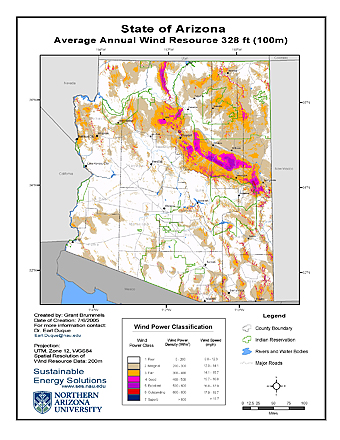Most viewed
- About NAU energy research
- Bicycle generator project
- 2015 Arizona wind & solar status report
- Education
- Energy experts
- Energy research
- Four Corners Wind Resource Center
- 2013 Arizona wind & solar status report
- Interactive Arizona wind map
Recent reports
- 2015 Arizona wind & solar status report
- 2013 Arizona wind & solar status report
- "The Future of Electricity: Embracing Transition"
- Prescott Airport solar facility & variability study
- Integration of Wind and Hydropower Systems: Issues, Impacts and Economics. Vol. 1
- Integration of Wind and Hydropower Systems: Case Studies. Vol. 2
Wind resource maps
Seasonal wind maps
Spring – Summer – Fall – Winter
Wind maps of Arizona at different hub heights
Monthly wind maps of Arizona
January – February – March – April – May – June
July – August – September – October – November – December
Wind map background
In August 2002, NAU contracted with True Wind Solutions to buy a set of high-resolution wind maps and the data from which the maps are created. Using a modified weather prediction computer program and 30-years of historical data, True Wind has created annual, seasonal, and monthly maps of average wind power density and average wind speed. Also included is data indicating the diurnal variation of the wind speed throughout the state. The set of wind maps was purchased for $65,000, of which $25,000 was provided by the National Renewable Energy Laboratory, and $13,333 each from Tucson Electric Power, Salt River Project, and Arizona Public Service. NAU serves as the central point of contact in arranging the purchase, and is responsible for making the maps and data publicly available.
What does the wind map tell us about the wind energy resource in Arizona?
Based on the wind map data, how much electricity could be generated by wind energy on the utility scale Arizona has a potential wind energy resource of more than 2600 MW. This estimate includes all areas in the state with a class resource or better (annual wind speed average at 50 meters above the ground greater than 16 mph), excludes windy sites such as urban areas, National Parks and Monuments, etc., but does not consider proximity to existing transmission. The highest wind energy resource areas appear to be concentrated along ridge crests and on plateaus in higher elevations throughout Arizona, especially in the northern and the eastern portions of the state. Two of the most promising tracks of contiguous windy lands in the state appear to be on the Navajo Nation near Cameron, and in eastern Arizona near Springerville. Arizona also appears to have a large class wind energy resource spread across the state (on the order of 20,000 MW), which may be developable for rural electrification, small home systems, or on a utility-scale in conjunction with a renewable portfolio standard.
Potential positive impacts of wind energy development
- Environmental, reduce or displace emissions from power plants
- Rural development, rural job creation and land leases to private land owners; possibly tax revenues
- Construction job creation, approximately one job per 1 to 10 MW of installed capacity (e.g., 100 MW of wind turbine development = 10 to 100 construction jobs)
- Long-term operations and maintenance (O&M) job creation, in the range of 2 to 10 long term O&M jobs per 100 MW of wind turbine development, depending on the size of the project and other factors.
Economic impact, typically between 10% and 25% of the capital investment (construction related costs) in wind turbine systems stay in the local/statewide community. Each megawatt-sized wind turbine requires an investment of approximately $1 Million, so a 100 MW wind turbine development could lead to an economic impact of $10,000,000 to $25,000,000. The Arizona Wind Working Group (see below) will be working over the next year to determine an Arizona-specific estimate of the potential economic impact.
Wind resource modeling
Researchers are using the new NAU computer cluster to run Weather Research and Forecasting (WFR) software that uses computational fluid dynamics to model the wind patterns within an area northeast of Flagstaff, in order to estimate the economic viability of installing small wind turbines for electricity generation at residences within the modeling area. Quantifying the wind resource at sites across the area allows homeowners to accurately predict the economic impacts of the decision to install a small wind turbine for electricity generation.
The next steps … what to expect?
Given the information provided by the new wind energy maps, there are several next steps to be taken in order to investigate the feasibility of developing the potential wind resource, as well as the possibility of realizing the potential benefits:
- Public outreach and education
- Site specific wind energy assessments of a duration of a year or more
- Transmission studies; potentially building more transmission capacity
- Environmental and avian impact studies
- Business planning and development assess the economic viability of developing the wind energy resource
Some of these steps have already been initiated by wind energy developers, utilities, and other groups in the state, and it is reasonable to expect that some of Arizona wind resource will be developed in the years ahead.
The Arizona Wind Working Group
The Arizona Wind Working Group was formed in November of 2001 with support of the National Wind Powering America Program. The goals of the Arizona Wind Working Group include determining the magnitude and geographic distribution of the wind energy resource available in Arizona and assessing the feasibility of commercial-scale development of Arizona wind resource. The group is composed of many stakeholders in the state including tribes, coops, utilities, universities, state and federal officials, private businesses, environmental organizations, and interested individuals. Purchase of the wind map was one of the first objectives of the Arizona Wind Working Group.
If you have questions, please call or email:
Dr. Tom Acker
Associate Professor, Mechanical Engineering
928-523-8363
tom.acker@nau.edu
